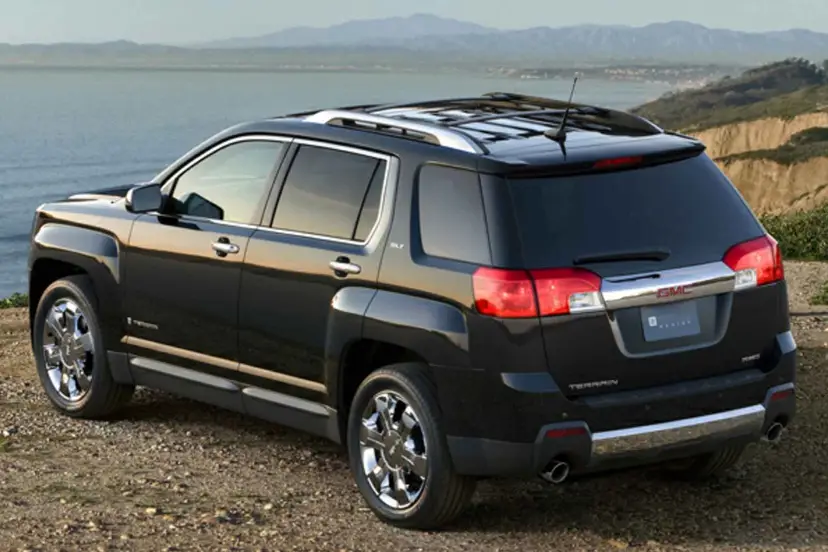
Rarely do I put more than 1,000 miles on a test car, but that’s what happened when the 2012 GMC Terrain came into my hands.
The verdict? Any vehicle that can keep me as happy, as free of back pain and as entertained as the 2012 GMC Terrain did for a thousand miles should win an award.
Actually, the Terrain’s twin, the Chevy Equinox, did win Cars.com’s $29,000 Shootout. My GMC tester cost significantly more than that, but still delivered a lot of value.
What’s New
Launched in 2010, the Terrain offers just a few updates for 2012, but what’s striking is that the crossover didn’t need much fixing. (See the two model years compared here.) The Terrain comes relatively well-equipped in its base, SLE trim level, which starts at $25,560. For 2012, the Terrain’s new standard features are technology-focused, including a new standard audio system with SiriusXM satellite radio, a 7-inch touch-screen and a USB input. Bluetooth, cruise control and OnStar remain standard.
Other new standard features include a backup camera whose image appears in the 7-inch display instead of the rearview mirror.
This higher level of standard features justifies the Terrain’s higher starting price versus the Chevy Equinox’s $23,530.
Performance
Whether you pick the four- or the six-cylinder engine, you’ll get a competent power plant, but not one that will stand out. My V-6, front-wheel-drive test vehicle had plenty of power to get up to speed on the highway, but the six-speed automatic wasn’t as smooth as others in this class. For most drivers, though, it likely will not be an issue.
We’ve had issues with the estimated mileage of the four-cylinder engine in the Chevy Equinox; it rarely reached the EPA’s 22/32 mpg city/highway numbers. The V-6 Terrain, over a thousand-plus-mile road trip, rarely dropped below the EPA’s 24 mpg highway rating. That was with just me and a suitcase, in cool weather — between 20 and 40 degrees — across flat land with a 70 mph speed limit most of the way.
Long cruises were where I really appreciated the Terrain’s quiet, comfortable ride. This type of ride is one reason automakers have shifted from a traditional SUV chassis to a more carlike one in crossovers like the Terrain.
In the Terrain, the move is welcome. My longest stretch of driving was nine hours, from Chicago to Toronto. Even during that drive, my back never became sore. The leather seats in the SLT trim were comfortable, with plenty of lumbar and thigh support. In comparison, I drove a smaller compact crossover on a particularly long commute, and my back was aching after an hour. Everyone’s body is different, but the comfort level of the Terrain and Equinox has been praised by other Cars.com editors as well.
Because of the spotty mileage issues with the four-cylinder and the reasonable $1,400 upgrade to the V-6, I recommend shoppers move up — something I’ve done less frequently lately, as four-cylinders across the industry have steadily improved.
Features & Technology
In every model except the base, SLE-1, adding a navigation system (which displays on the 7-inch touch-screen) costs just $795 — a relative bargain, given most systems cost well above $1,000 as stand-alone options or even more as part of option packages.
I simply loved the multimedia and navigation system in the Terrain. It utilized the best of the touch-screen world as well as having physical buttons and knobs. I probably wouldn’t rave as much about this mix of controls if it weren’t for the fact that Ford relies on touch-sensitive panels that have irked our staff recently. The layout and screen clarity are a bit cleaner than that of the new Honda CR-V, but it’s a close call.
iPod integration in the Terrain is flawless. This, combined with the upgraded sound system, put me in music geek heaven as I crossed state and international borders. Its Bluetooth pairing was simple and effortless, but most manufacturers have perfected this. I found the nav system to be above average, as well. I particularly liked the ability to display navigation cues in the small LCD screen in the gauge cluster, supplementing the map on the touch-screen. That was a good place to see the mileage tick down before a necessary exit or freeway exchange.
I’m not one for voice controls, as a few simple button clicks seem more intuitive and faster, but the Terrain’s work about as well as Ford’s Sync voice recognition system and the new system from Honda.
Forward collision alert and lane departure warning systems were also on my tester. At just $295 as a bundled option on the highest, SLT-2 trim — the only version on which they’re available — they seem like a bargain, especially if you do a lot of bumper-to-bumper driving (for the former) or long stretches using cruise control (for the latter). These systems were introduced just a few years ago on luxury models, and it’s nice to see them available on an affordable model at a very affordable price.
Versus the Competition
The tough thing for the Terrain — and the Equinox — is where they fit among the competition. They’re larger on the outside than traditional compact SUVs like the Honda CR-V and Toyota RAV4 but offer less interior and cargo volume. They’re more expensive, too. They’re slightly smaller (but less expensive) than full-size crossovers and SUVs like the Ford Edge and Nissan Murano, both of which can be had with power plants I prefer to GM’s.
The Dodge Journey was recently refreshed and is the most similar to the two GM products in terms of size and pricing, but the Terrain tops it in terms of performance and tech features.
See the Terrain compared with similarly equipped competitive models here.
Unlike some of the competition, the Terrain features a sliding second row, which is a crowd-pleasing feature when you’re taking friends to dinner and don’t mind losing cargo space by sliding the backseat rearward.
But that lack of cargo volume is substantial. I’m glad they don’t call it an SUV, because there isn’t much utility in the Terrain. At 31.6 cubic feet, the cargo area is significantly smaller than the CR-V’s 37.2 cubic feet or the Journey’s 39.6 cubic feet, and it’s just a smidge behind the Edge’s 32.2 cubic feet. The bigger issue with the Terrain is that the cargo area is particularly narrow, so items like golf bags and strollers have a hard time fitting horizontally across the back.
This limits the Terrain’s value to families with small kids, given the equipment they require. For those looking for a car to do standard hauling jobs, like grocery store trips or discount-club shopping runs — sans passengers — it will do the trick.
Safety
The Terrain was named a Top Safety Pick by the Insurance Institute for Highway Safety, the organization’s highest crash rating. It scored four stars out of five in the federal government’s overall crash rating. In individual government tests, it earned four stars in frontal crashes, five stars in side-impact tests and a four-star rollover rating.
You can find all the Terrain’s safety features here.
Terrain in the Market
The Terrain — along with the Equinox — is a terrific option for compact-crossover shoppers who want a more substantial feel out of their ride. It also packs all the current technology and safety features you would want in a car in this segment and price range.
Since it debuted in 2010, the Terrain has been a sales hit. Even with just a few minor upgrades, it should remain popular in 2012.
| Send David an email |






















































